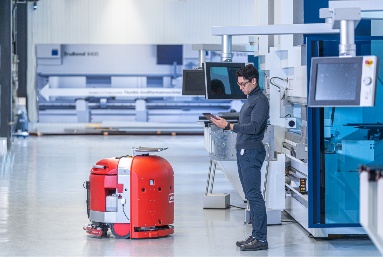THE EV GROWTH STORY IS INTEGRAL TO INDIA’S GROWTH STORY

Mahindra Electric (ME), a frontrunner in the electric vehicles space in India is taking big strides on both the product development as well as the marketing fronts. The year 2018 has been a big year for ME where it has seen an upswing in the demand and its initiatives in the areas of mass mobility and powertrain technology are paying off.
Dynamic Manufacturing India Magazine Team (DMI ) had the opportunity to interact with Mahesh Babu, CEO, Mahindra Electric where we discussed ME’s unique go-to-market strategy, the importance and evolution of charging infrastructure in India and the top learnings that Mr Babu have had in the course of positioning ME as a company that seeks to bring sustainable, electric-powered mobility to the masses.
The demand for electric vehicles (EVs) is apparently the most important piece of its market strategy, and you have been doing some great work in creating demand for Mahindra Electric Vehicles. What is your perspective on the significance of demand in EV selling? What are the initiatives that you have been taking in this direction and have plans for?
Let’s go back five years to the time we launched Mahindra e2o – we had been selling the cars primarily to individuals; there were not much traction [in this segment]. We realized that the individual customers – a majority of whom were environmentally conscious – were very few in number then. Most car customers [across segments] were looking at the economic value of a car. Therefore, we decided to focus on the fact that electric vehicles (EVs) are
operationally very low cost. For example, an electric car runs at Re 1 per km compared to Rs 4.50 or 5 per km for a petrol or diesel car. Electric vehicles are slightly higher in the initial acquisition cost, but when you run it, you realize that you are
not losing money but, in fact, making money.
With your EV, within two years you are able to break-even and get back your initial investment.
With that [selling point] in focus we led our pilot with the Lithium Urban Technologies, a Bengaluru-based electric vehicle fleet operator, with 100 electric cars. Now they have a fleet of more than 500 Mahindra Electric cars. These are the cars that run around 150 to 200 km a day. Further, we have also tied up with cab aggregator companies such as Ola and Zoomcar. We have recently announced our partnerships with Uber and Meru as well. That is how we have started to leverage the mass mobility ecosystem. Also, in the fleet segment, the corporate commuting part presents a huge advantage for EVs since the charging infrastructure comes captive – you can set up a charging station in the respective office premises. That’s how we made an electric vehicle more amenable to fleet operations. We took this vision to everybody, including the Olas and the Ubers. For example, with Lithium Urban Technologies, we have run more than 20 million km. With Ola we are at 2.5 million km. We are as thrilled about our initiative with Zoomcar because people would start taking EVs to travel within the city – the most amenable segment for such usage is the electric vehicle segment.
At Mahindra Electric, we don’t only work on the products, we work on the ecosystem to promote and increase the usage of EV in the market.
Another exciting development has been our connect with Energy Efficiency Service Ltd(EESL), which is the Power Ministry’s pet initiative in the area of energy-efficiency. [Energy Efficiency Services Limited (EESL) is an energy service company (ESCO) of the Government of India and is the world’s largest public ESCO. – Editor].We have been working closely with the government and other agencies [for policy support] because electric motor is at least three to four times
more efficient than the regular gasoline or
diesel engines.
To answer your question about how the demand will change the whole system; one is, we have always been saying that we are at the forefront of the EV revolution in India, but we don’t want to be the only one. If we are alone that means it is not a viable business model. So we are happy that competition is coming in.
I am sure that what we have learnt over the last decade will definitely help us to position ourselves differently. The increased demand will cause the cost to come down because vendors, instead of making 10 parts a day, which is not viable for them, will make hundreds of parts a day. The cost of vehicles will also come down, the skill-sets will improve, our suppliers, who are waiting and watching, will now start investing more, because they will see a stable demand from the government and the market in general. Demand is the most critical thing which will change the complete electric vehicles scenario and I am happy that it is seeing a healthy growth this year.
You worked as VP – Product Development with Mahindra and Mahindra for 16 years and have been a part of the leadership team that positioned and launched a number of successful models. Any insights and learnings from your earlier term that perhaps you have applied to Mahindra EVs in terms of design, development, and marketing?
Our learning has been that there has to be a strong customer-connect when creating a product. Unfortunately, for the electric vehicle in the four-wheeler segment till now we couldn’t justify a huge investment because the volumes are much lower than any investment. Any automobile investment needs at least about hundred-thousand units per annum of volume to invest. I would say that we have used the learnings [from Mahindra and Mahindra Automotive] in the launch of our three-wheeler. We unveiled Mahindra TREO [three wheeler with Li-Ion batteries] at the 2018 Auto Expo. It almost followed a very similar path of SUV development where we had gone to the customer, understood what they want, and incorporated all those insights into the product. If you see the backseat of TREO, it has a spacious leg room which is as big as the leg room you got in the middle or the front-row seat of an SUV. We strongly believe that TREO will become a successful product considering the response we have received so far.
Mahindra EVs offer a number of features, for example, the performance monitoring and the regenerative breaking systems. How are these features helping the sales? How are the customers responding to it and what is the overall thought behind packing it with state-of-the-art technology features?
The electric vehicle is a technologically-advanced concept. While it is very simple to operate, it needs to be supported by superior technology, much like an Apple iPhone. There is a huge amount of work that goes behind the scenes to make it easy to handle for customers.
In our cars, 2-3 technological features have been highly appreciated by our customers. Our Telematics and NEMO (Next-Gen Mobility) solutions allow the customer to monitor details and updates about the vehicle on a regular basis. Our mobile app provides features such as monitoring of the charging status – they can even pre-cool it during the summer before getting in. These are all the technological features that are creating a huge value. Now, we are also looking at creating value with big data analytics through our Telematics technology and NEMO platform. Going forward, we will be giving a lot of value-added services for the customers related to the location of the charging stations, the status of car servicing, traffic updates and other such features.
Internationally, EVs’ performance is being marketed as a key differentiator, for example, how a particular EV model can accelerate from 0 to 60 MPH in less than 5 seconds. But in India, in terms of positioning, the focus is on economic value. Why this difference?
Mahindra believes that the electric vehicles should be made available to the masses in India. It has to be adopted on a large scale by the Indian consumers first. The economic and social conditions of the West and those of India are quite different.
We strongly believe that a technology should not only appeal to an individual but it should address the social needs. Today, we have a problem of highly polluted cities. We have a problem of traffic congestion; we have a problem of unavailability of clean energy, and so on.
We have responded to and address requirements suitable to the Indian vehicular ecosystem and customer segments. For example, when we saw that fleet operations is the right way to go, we developed a five-seater e-Verito sedan which is the right fit for fleet operations. To address the last-mile connectivity requirements in the cities, we launched the e-Supro cargo and passenger van. Similarly, the e-Alfa three-wheeler and the e-Cosmo bus constitute our offerings that meet the requirements of the specific segments.
Our focus till now has been on mass mobility, whether it is fleet operations or last-mile connectivity or public transport. This is what
I would call the EV 1.0 strategy. And you know that we have announced EV 2.0, whereby we are developing a high-performance powertrain of 150 kilowatts, 400 Newton-meters range. We said that we have already announced our tie-up with LG Chem as part of which we will make state-of-the art battery modules and a unique India-specific cell will be of a very high density.
We will also develop power electronics where we can do fast charging in 40 minutes or less. These technologies will be applied to our products to bring performance to the levels where, as you have cited, 0 to 60 MPH in a few seconds could be the target.We are working on a futuristic SUV, which will come up with these performance targets. We were focusing on the mass market now, along with which we are moving into performance. Products which are in line with EV 2.0: powertrains, new technologies which will have a globally competitive impact and at the same time we will have products addressing the Indian mass market mobility.
The powertrain system that you are supplying to SsangYong and to Mahindra &Mahindra overseas – what is the size and positioning of that part in your overall business size?
I believe that our supplies to SsangYong and other players overseas give us a global exposure because as our powertrains will be adopted internationally, we will be able to bring that value back to the Indian market. At the same time, we will continue to be innovative and unique to address the needs of the Indian customer with three- wheelers, buses and other offerings. I see that we will be the only company, which I can say by even now,that, by 2020, will be present in every segment – from three-wheeler to an electric bus; catering to India as well as international markets. This is our strength now and that will be our strength going ahead.
You recently unveiled your plans to ramp-up production at Chakan and Bengaluru facilities to 20,000 units in the next three years. How do you foresee the demand that will match the increased production at your facilities?
If you look at last year’s business, we hardly had sales of, say, 1,200 to 1,300 electric vehicles. However, we have already gained a high number this year. I can’t reveal the numbers now but
what I can say is that you can assume if EESL
has already issued a tender of 10,000 EVs
and they have come up with a second 10,000 tender – even if Mahindra Electric gets 50% or even 30% of the order, that is a huge number. In the first tender we already got 50% so we are supplying overall more than 5,000 vehicles to them. As you know we have already announced a deal with the Bengaluru-based fleet operator Bhagirathi for 1,000 vehicles. If you look at all this, I think this year our numbers will be substantial. We are also expanding our facilities to make three-wheelers. We have to able to supply to SsangYong, Mahindra and for all those products we need a new plant with new technologies and that is the reason that a plant is going to be set up at Chakan in Pune.
How do you see the development of the EV charging infrastructure in India which is very crucial to the growth of this segment?
As you rightly said that the charging infrastructure is crucial to the electric vehicles growth story. If you would have asked me one year back, my answer would have been different, but I think a lot of progress has been made in the last one year. The Power Ministry has given a clarification that charging an EV is no more deemed as a sale of electricity because in India nobody can sell electricity other than the government and government-appointed agencies. This is a very significant clarification given by the Ministry of Power. That will help many players to come forward and setup the charging infrastructure. The second thing that I am very happy about is that the charging infrastructure is going to get support from three segments. One is through fleet management. Since a fleet movement is predictable, the charging points can be set at captive locations. EESL has ordered about 2,000 charging points, which has recently been won by Exicom Tele-Systems.
Then we have the public charging infrastructure. We are working very closely with NITI Aayog, the Power Ministry and the Department of Heavy Industries. I am happy to see that the government tenders are being issued not only for vehicles but also for the charging infrastructure. I think it is a very positive start. One of the good things about India is that it may take time for things to start, but once they do, the speed is phenomenal. Just like you saw with the internet, mobile phones, LEDs and other utilities.
Is there a supplier network or a vendor network ecosystem present in India that could support your growth plans going forward?
There is a vendor network in India. Right now it is small, but very eager to invest if you ask me. A lot of components are sourced. We are already buying the motor from Kirloskar, the charger is brought from one or two power electronics vendors in Bengaluru. The battery management system is our own but we have the PCB (Protection Circuit Board) printed and packaged from outside. India has a strong electronics base, particularly in software. I am sure that the hardware side will also pick up with the new policies that the government has brought in on mobiles and electronics.
We have been working with ACMA (Automotive Component Manufacturers Association of India) and government functionaries on the policy side. Many manufacturers are showing keen interest in EV components but the challenge is that they need to see a consistent policy support. By way of the EESL order of 20,000 the government has sent a positive message. Plus, the FAME [Faster Adoption and Manufacturing of Electric Vehicles] India program is got an extension and has being seen as a long-term rather than a short-term policy initiative. All these steps are based on the inputs from the industry, including the manufacturing industry, that ‘give us a long-term vision of three to five years so that we can invest, we can serve the industry and become a part of the turnaround story in India’.
What position and future do you see and role do you see of India in the global EV industry growth story?
I always have seen that India’s market is quite unique. First, the Indian economy is growing at a fast clip which entails that transportation and communication are the two areas that are going to see the fastest growth. India is one of the largest two-wheeler and three-wheeler markets globally, while it very low in car usage – it is just 20 cars per thousand compared to others [the US has 439 cars per thousand people]. Mahindra Electric, with its range of four-wheelers and three-wheelers for a whole range of segments, can address that gap along with the other players.
India is also unique in the sense that if you just sell technology, people will not buy it. They will buy solutions instead that address individual or social problems. I strongly believe that an EV has very important role to play in this aspect.
The rate at which our cities are growing is phenomenal. Cities like Bengaluru and Gurugram are completely different from what they were merely 10 years ago. If you are growing at this rate, and you want to keep the pollution under check, then EVs will certainly play a role.
You look at the speed at which sustainable energies are gaining ground in India. India, for example plans to set a 20 GW of grid-connected solar energy capacity by 2020. It is close to achieving the target in 2018. Now they are talking about more 60 GW in the next two years. The growth story of electric vehicles is integral to the growth story of clean energy.
Even on the expenditure side, we have a huge oil import bill, and we import 85 percent of oil. You can’t afford to spend foreign exchange reserves on this scale for a long time. That is why EVs are needed more in India as they are in Europe or the US. China has the same problems of high growth and high pollution; they have gone the whole nine yards on electric mobility because in their national interest and people’s interest. We have to adopt a similar approach.





